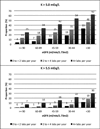Antihypertensive Medications and the Prevalence of Hyperkalemia in a Large Health System
- PMID: 27067721
- PMCID: PMC4865437
- DOI: 10.1161/HYPERTENSIONAHA.116.07363
Antihypertensive Medications and the Prevalence of Hyperkalemia in a Large Health System
Abstract
Little is known about the frequency and patterns of hyperkalemia in clinical settings. We evaluated the association between baseline antihypertensive medications that may affect potassium levels (angiotensin-converting enzyme inhibitors, angiotensin receptor blockers, β-blockers, loop/thiazide diuretics, and potassium-sparing diuretics) and hyperkalemia, defined by potassium >5 mEq/L and >5.5 mEq/L, over a 3-year time period in 194 456 outpatients in the Geisinger Health System, as well as actions taken after an episode of hyperkalemia. The proportions of patients with 0, <2, 2 to 4, and ≥4 potassium measurements per year were 20%, 58%, 16%, and 6%. Potassium levels >5 mEq/L and >5.5 mEq/L occurred in 10.8% and 2.3% of all patients over the 3-year period; among patients with ≥4 measurements per year, corresponding values were 39.4% and 14.6%. Most cases of hyperkalemia occurred only once during follow-up. The antihypertensive medication class most strongly associated with hyperkalemia was angiotensin-converting enzyme inhibitors. Among patients with a measurement of potassium >5.5 mEq/L, only 24% were seen by a nephrologist and 5.2% were seen by a dietician during the 3-year period. Short-term actions after a potassium measurement >5.5 mEq/L included emergency room visit (3.1% within 7 days), remeasurement of potassium (44.3% with 14 days), and change in a potassium-altering medication (26.4% within 60 days). The most common medication changes were discontinuation/dose reduction of an angiotensin-converting enzyme inhibitor/angiotensin receptor blocker or potassium-sparing diuretic, which occurred in 29.1% and 49.6% of people taking these medications, respectively. In conclusion, hyperkalemia is common. Future research may enable optimal renin-angiotensin-aldosterone system inhibitor use with improved management of hyperkalemia.
Keywords: antihypertensive; hyperkalemia; medications; potassium; renin–angiotensin–aldosterone system.
© 2016 American Heart Association, Inc.
Conflict of interest statement
None
Figures



References
-
- Rimmer JM, Horn JF, Gennari FJ. Hyperkalemia as a complication of drug therapy. Arch Intern Med. 1987;147:867–869. - PubMed
-
- Acker CG, Johnson JP, Palevsky PM, Greenberg A. Hyperkalemia in hospitalized patients: Causes, adequacy of treatment, and results of an attempt to improve physician compliance with published therapy guidelines. Arch Intern Med. 1998;158:917–924. - PubMed
-
- Weir MR, Rolfe M. Potassium homeostasis and renin-angiotensin-aldosterone system inhibitors. Clin J Am Soc Nephrol. 2010;5:531–548. - PubMed
Publication types
MeSH terms
Substances
Grants and funding
LinkOut - more resources
Full Text Sources
Other Literature Sources
Medical

